This component is known as the 3D printing filament that is processed at a high temperature to convert it into a semi-solid form. Once it has achieved this state, the machine can easily create layers of required design and print the 3D model onto the printing bed. There are a lot of different properties of these filaments that affects the end results such as:
Material: The material of the printing filaments decides the quality of your end results. Different materials consist of different chemical and physical properties that have an important role in the quality and application of the final model. Temperature Range: As 3D printers come in all budget ranges, not every 3D printer is capable of the same performance. Thus, your 3D printer must be able to maintain the nozzle temperature high enough for the filament to be properly melted. Compatibility with the printer: The 3D printing filament you are going to buy must be perfectly compatible with your 3D printer. Failing that, your 3D printer will not be able to provide you satisfying results no matter how detailed and perfect your design is.
Selecting the perfect 3D printing filament according to your usage and requirement is crucial to get the best printing results. Today, we will talk about the best 3D printing filaments and give you detailed information on each option. You can also find a special “Buying Guide” for the 3D printing filaments available in this article that will guide you towards the best purchase.
Best 3D Printing Filaments Tabulation
Best 3D Printing Filaments 2023 Reviews
1. OVERTURE PLA 3D Printer Filament
PLA is the most common type of filament used by a large number of 3D printers. Therefore, we will focus on general PLA filaments in this part of the article that are offered at a cheap rate and get the job done without any problem. The OVERTURE PLA Filament is one of the most acclaimed PLA filaments out there with quite a positive user response. Each spool of this filament weighs 1 Kg and comes with a 200 x 200 mm build surface. The OVERTURE PLA Filament is designed with a clog-free patent so that the printing experience is always uniform and smooth throughout its usage. The advanced dimensional measuring and automated manufacturing system of these filaments confirm a diameter of 1.75 mm and a dimensional accuracy of +/- 0.05 mm. Overture has been making filaments for a very long time and their options are highly cost-effective and reliable. Best Features:
PLA filament material 1 Kg spool weight Comes with a 200 x 200 mm build surface +/- 0.05 mm dimensional accuracy
Pros:
One of the best PLA filaments in the market Designed with precision
Cons:
Comes at a higher cost than other PLA filaments Constructional strength is lower
2. HATCHBOX PLA 3D Printer Filament
Due to the increasing demand for PLA materials for 3D printing, we are featuring a couple of budget-friendly PLA printing filaments on our list. Out of which, the HATCHBOX PLA 3D Printer Filament is a preferable option because of its 1.75 mm standard diameter and a pinpoint tolerance accuracy of +/- 0.03 mm. It is also shipped in vacuum-sealed packaging to avoid problems in the shipping. Hatchbox has mentioned a suitable temperature range for this filament which is around 180- 220°C and each spool of this PLA filament weighs around 1 Kg. As for the spool, it has a large 7.88 inches diameter and 2.69 inches width that avoids problems with the feeding mechanism. It also has a hub diameter of 2.20 inches that is accepted by most machines. Best Features:
PLA filament material 75 mm diameter +/- 0.03 mm tolerance 180- 220°C temperature range
Pros:
A great option for first-time users Best filament for testing different designs
Cons:
Cheaper PLA options are available Products do not have a pleasing finish
3. SUNLU PLA 3D Printer Filament
If you liked the carbon fiber filament from SUNLU, then you will like its PLA filament variant available at the most budget-friendly price tag from our list. It carries similar high quality in production as we saw in the earlier pick with high purity of material and low shrinkage problem. This offers the best layer bonding amongst many other PLA based filaments and increases the quality of the model. It follows a strict tolerance of +/- 0.02 mm through its periphery and provides a uniform diameter of 1.75 mm for the whole filament spool. The spool itself weighs 1 Kg when it is unused that ensures the quantity of filament available with the spool. It has been dried for 24 hours before packaging so it comes in clog-free and bubble-free packaging. Best Features:
Low shrinkage problem Best layer bonding amongst +/- 0.02 mm tolerance 75 mm diameter 1 Kg spool
Pros:
It has a manageable temperature range of 215-220°C Easily available without high investment
Cons:
Cannot be used for heavy-duty modeling Limited color options available
4. TECBEARS PLA 3D Printer Filament
PLA material has a lot of applications such as tools, small equipment, artistic products, decorative modeling, toy making, replacement parts, and many other uses. Thus, most users prefer a color choice to be able to print these products with a different finish. TECBEARS PLA 3D Printer Filaments are offered in a lot of colors and shines that make the final products very attractive to look at. Also, these filaments are the cheapest PLA options that you can find out there. The TECBEARS PLA 3D Printer Filaments are designed with high purity and made out of 100% environment-friendly natural materials that are biodegradable. Thus, the printed objects of these filaments do not add to the existing plastic waste on the planet. Although, these filaments are prone to get damaged from moisture and must be stored in a moisture-free place. Apart from that, it has a standard 1.75 mm diameter and +/- 0.02 mm tolerance. Best Features:
Great choice of colors available Most affordable PLA filaments Made with high purity Made out of environmentally friendly material 75 mm filament diameter +/- 0.02 mm tolerance
Pros:
Comes at a very affordable price tag Great color choices available
Cons:
Only suitable for casual use Model strength is less
5. Silk Metallic 3D Printer Filament
In the 3rd position, we have more of a combo offer for you as you get not 1 but 3 different spools in one package. This is also quite a unique printing filament thanks to its shiny silky finish on the outside. Mika3D offers these filaments in many different colors so that you can choose between a lot of options. The 3D printed items from these filaments have a shine on them and thus, they look very attractive. The Silk Metallic Shiny Red Copper PLA Filament spools are universally compatible with all FDM 3D printers currently available in the market. It also melts pretty well under the temperature limit of 205-230°C so that it can be fed smoothly and uniformly. Another advantage of Silk PLA filaments is the 100% tangle-free operation that can create a lot of problems while printing. Best Features:
3 spools available in the package Silky finish available on filaments Printed objects are shinier in nature Universally compatible with FDM 3D printers 205-230°C temperature range 100% tangle-free operation
Pros:
Does not create any problem in feeding A lot of color choices available
Cons:
Package price is high The individual spool has less quantity of filaments
Best Features:
PETG filament material No heating bed required 75 mm diameter Best for casual use Great adhesion A glossy finish can be obtained
Pros:
It offers a versatile application range Designed to avoid jamming in the machine
Cons:
A suitable temperature limit is not provided User responsive is not as high as other options
7. SUNLU Carbon Fiber PLA 3D Printer Filament
Up next, we have yet another sturdy carbon fiber filament available from the SUNLU store. This variant of carbon filament is comparatively cheaper than our 1st pick and also comes with a more precise tolerance level. The SUNLU Carbon Fiber PLA Filament has an identical 1.75 mm diameter but with a tolerance zone of +/- 0.02 mm. Each spool weighs around 1 KG that makes it worthy of its price tag. Similar to other carbon fiber PLA filaments, it also needs the operating temperature range of 190-230°C that is quite high and not available in most entry-level 3D printers. Although, if you have a high-end 3D printer, it is perfect for casual as well as professional printing because of its perfect dimensional accuracy and warp-free operation. The filament is completely biodegradable which makes it completely environment friendly. Best Features:
75 mm diameter +/- 0.02 mm tolerance range 190-230°C temperature range
Pros:
This filament is not harmful to the environment Even filament diameter
Cons:
Expensive option as compared to regular PLA filaments Not suitable for entry-level machines
8. iSANMATE 3D Printer Filament
In the 2nd position, we have placed yet another unique 3D printing filament which is quite different from generic options. The 3D printing filament from iSANMATE features 20% wood and 80% PLA material that delivers a gorgeous wooden finish to the printed objects. This helps you to create a wooden texture in almost every design and give it a natural touch. Even with the wooden compound, this filament can be used on a temperature range of 190-225℃ with a dimension of 1.75 mm. It also has a similarly precise tolerance range of +/- 0.0 03 mm which is considered pretty uniform throughout the spool. Talking about the spool, it has 7.76 inches diameter with a weight of 1 KG that is pretty much standard for filaments. The iSANMATE Wood Filament is completely environment friendly and offers a decent amount of layer bonding and strength. Best Features:
20% wood and 80% PLA material Creates a wooden finish on the printed objects Wooden texture can be created in the design 190-225℃ temperature range 75 mm diameter with +/- 0.0 03 mm tolerance
Pros:
Suitable for artificial showcasing items A great option for hobbyists
Cons:
Comparatively expensive than most other options Printed products are somewhat brittle
9. PRILINE Carbon 3D Printer Filament
Carbon fiber is widely known for its high stiffness and strength as compared to other compounds. Therefore, the PRILINE Carbon Fiber Polycarbonate is an ideal candidate for creating applicable 3D printed products that are going to be under a load or hanging from a place via a part of its structure. This filament has carbon fiber polycarbonate material and weighs almost 1 KG per spool. The size of this filament is 1.75 mm with a tolerance level of ± 0.03 mm which is quite low considering other options. The spool diameter is nearly 7.87 inches with the hub diameter being 2.20 inches so that it’s suitable for the most popular 3D printers As the material is strong, it requires a higher temperature than other options which is 240-260°C with a base plate temperature range of 80-100°C. If your machine matches these parameters, the PRILINE Carbon Fiber Polycarbonate will deliver flawless printing results with precise dimensions and build quality. Best Features:
High stiffness and strength Ideal for heavy-duty objects Carbon fiber polycarbonate material 1 KG spool weight Carbon fiber polycarbonate material
Pros:
Delivers decent rigidity in 3D printed objects Heavy-duty material
Cons:
Expensive 3D printing filament Recommended temperature range is high
10. Dremel DigiLab PLA 3D Printer Filament
Coming to our last pick for the best 3D printing filaments, we have but one more PLA material filament coming from a fresh brand called Dremel. Dremel is claiming to have tested a new and tested material for this filament that has an improved print quality and reliability. It is made out of plant-based material. The filament has a 1.75 mm diameter and is compatible with all Dremel Digilab 3D printers and many other manufacturers. It is recommended to use this filament only at 230°C temperature and a heated bed with a temperature of 60°C. It is best for trying our non-functional designs and check the level of details provided in the design. Each spool of Dremel DigiLab PLA-TRA-01 weighs 0.75 Kg and the filament is offered in many different colors. Best Features:
New and tested PLA material Plant-based material used in production Improved print quality and reliability 75 mm diameter 230°C nozzle temperature and 60°C bed temperature required 75 Kg spool weighs
Pros:
Vivid range of colors available Print quality will be decent
Cons:
Suitable for non-functional design Spool weight is lower in comparison
Buying Guide For The Best 3D Printing Filaments
Even though you can simply try different types of printing filaments before finding the one that suits your machine perfectly, it is not the most efficient way of 3D printing. For printing different types of objects, you will require different printing materials that operate under different conditions. The 3D printing filaments mentioned above are some of the best options from the plethora of options present in the market. We have selected these particular options based on the most important properties of a 3D printing filament that affects its application the most. Here are some of those properties that you need to keep in mind before buying a brand new spool of a 3D printing filament.
1. The material of The Filament
The filaments used for 3D printing comes in different types of material such as PLA, ABS, Carbon Fibre, Wood, and many more. Different types of materials offer a unique result whether you are considering the quality of the result of the aesthetics of the model. This also includes different types of finishes on the models where some have a matt finish and some feature a glossy finish. The filament material that you will choose depends upon how you want your product to look once the printing is finished.
2. Recommended Temperature Range
TAs you may already know, 3D printers work on the principle of heating up the filament and then letting it cool at room temperature to create a model. The suitable printing temperature for different materials is different and so are the capabilities of different 3D printers. Thus, your printer must be able to reach the required heating temperature of the filament to produce the perfect 3D model.
3. Price Range and Quantity
While going through our list, you must have noticed that the filaments are available in varying price ranges. This is because different brands utilize different types of manufacturing methods. Also, the shipping method changes from brand to brand. With a premium option, you will likely get more amount of filament and it will be shipped with maximum safety. Although, you should not spend extra money on a filament material that you do not have any use for.
4. Application
Lastly, we will recommend you carefully decide your application type before buying the filament for your 3D printer. The change in the application requires a change in filament types. For example, a functional 3D model must be made out of a durable material that is capable of withstanding certain force without failure. On the other hand, decorative subjects can be made out of wooden or PLA materials without any problem.
Conclusion
Whether you are using your 3D printer as a hobby or for commercial purposes, you will always require a decent 3D printing filament that can be converted into the best quality 3D product and also provide an appropriate resistance against impacts and fatigue. Even if you own a highly premium 3D printing machine, you cannot do much with it unless you get an equally decent 3D printing filament. If you have already gone through our list of the best 3D printing filaments, you must have selected the perfect option according to your use by now. If not, you can go with one of our top recommendations provided below.
Our first recommendation would be the PLA 3D Printer Filament from SUNLU. This filament is made up of PLA material and naturally, comes under a very affordable price range as compared to other options. Although we are recommending this option because of its high user rating that confirms its reliable performance. You must have heard about carbon fiber before as it is one of the most durable compounds. You can find this compound in 3D printing filaments too with PRILINE Carbon Fiber Polycarbonate 3D Printing Filament. But, make sure your 3D printer can support its high-temperature range of 240 to 260°C. There are a lot of 3D printer owners that use their machine to generate aesthetically pleasing 3D models. In case you are also thinking about a similar application, the iSANMATE Wood 3D Printing Filament will be the best option for you. This filament creates a wooden finish on the result that is best for showpieces.
Comment * Name * Email * Website
Δ




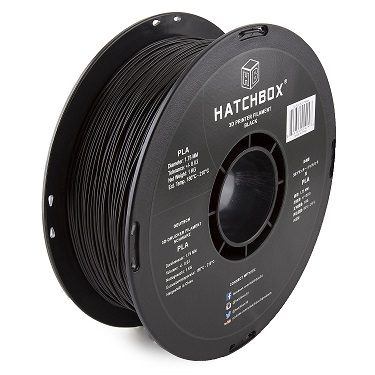
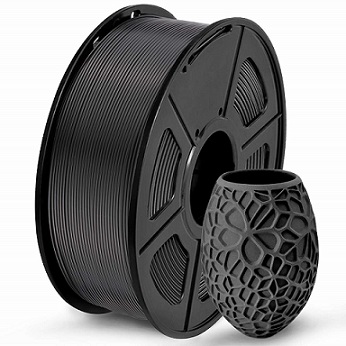
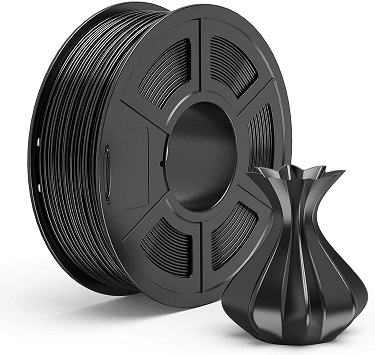
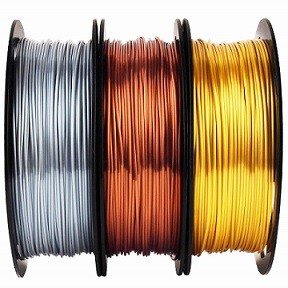
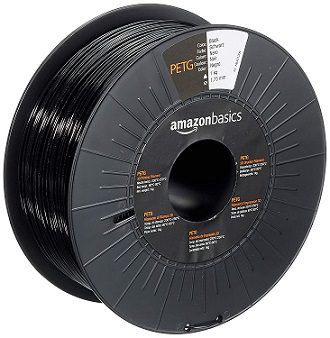
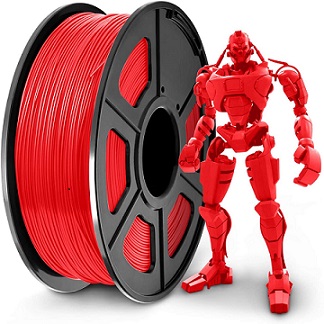

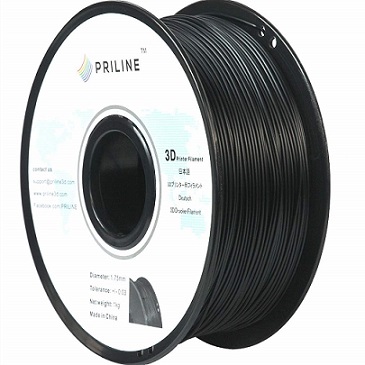
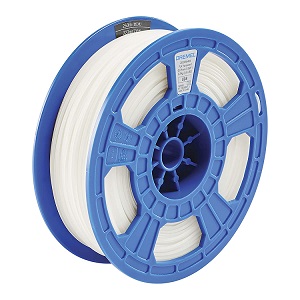


![]()